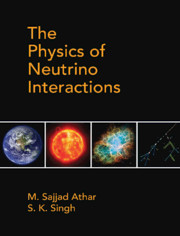Book contents
- Frontmatter
- Dedication
- Contents
- List of Figures
- List of Tables
- Preface
- Acknowledgments
- Chapter 1 Neutrino Properties and Its Interactions
- Chapter 2 Relativistic Particles and Neutrinos
- Chapter 3 Quantization of Free Particle Fields
- Chapter 4 Interacting Fields and Relativistic Perturbation Theory
- Chapter 5 Phenomenological Theory I: Nuclear β-decays and Weak Interaction of Leptons
- Chapter 6 Phenomenological Theory II: Weak Decays of Hadrons
- Chapter 7 Gauge Field Theories and Fundamental Interactions
- Chapter 8 Unified Theory of Electroweak Interactions
- Chapter 9 Neutrino and Electron Scattering from Point Particles
- Chapter 10 Neutrino scattering Cross Sections from Hadrons: Quasielastic Scattering
- Chapter 11 Neutrino Scattering from Hadrons: Inelastic Scattering (I)
- Chapter 12 Neutrino Scattering from Hadrons: Inelastic Scattering (II)
- Chapter 13 Neutrino Scattering from Hadrons: Deep Inelastic Scattering
- Chapter 14 Weak Quasielastic v(⊽)-nucleus Scattering
- Chapter 15 Inelastic Scattering of (Anti)neutrinos from Nuclei
- Chapter 16 Deep Inelastic Scattering of (Anti)neutrinos from Nuclei
- Chapter 17 Neutrino Sources and Detection of Neutrinos
- Chapter 18 Neutrino Mixing and Oscillations
- Chapter 19 Neutrino Astrophysics and the Synthesis of Elements
- Chapter 20 Neutrino Interactions Beyond the Standard Model
- Appendices
- Appendix A Lorentz Transformation and Covariance of the Dirac Equation
- Appendix B Cabibbo Theory
- Appendix C Some Properties of Pauli and Dirac Matrices and Spin Density Matrices
- Appendix D Leptonic and Hadronic Tensors
- Appendix E General Expression for the Total Scattering Cross Section and Decay Rates
- Appendix F Expressions of N(q2), the Coefficients of the Polarization Observables
- References
- Index
Chapter 5 - Phenomenological Theory I: Nuclear β-decays andWeak Interaction of Leptons
Published online by Cambridge University Press: 22 May 2020
- Frontmatter
- Dedication
- Contents
- List of Figures
- List of Tables
- Preface
- Acknowledgments
- Chapter 1 Neutrino Properties and Its Interactions
- Chapter 2 Relativistic Particles and Neutrinos
- Chapter 3 Quantization of Free Particle Fields
- Chapter 4 Interacting Fields and Relativistic Perturbation Theory
- Chapter 5 Phenomenological Theory I: Nuclear β-decays and Weak Interaction of Leptons
- Chapter 6 Phenomenological Theory II: Weak Decays of Hadrons
- Chapter 7 Gauge Field Theories and Fundamental Interactions
- Chapter 8 Unified Theory of Electroweak Interactions
- Chapter 9 Neutrino and Electron Scattering from Point Particles
- Chapter 10 Neutrino scattering Cross Sections from Hadrons: Quasielastic Scattering
- Chapter 11 Neutrino Scattering from Hadrons: Inelastic Scattering (I)
- Chapter 12 Neutrino Scattering from Hadrons: Inelastic Scattering (II)
- Chapter 13 Neutrino Scattering from Hadrons: Deep Inelastic Scattering
- Chapter 14 Weak Quasielastic v(⊽)-nucleus Scattering
- Chapter 15 Inelastic Scattering of (Anti)neutrinos from Nuclei
- Chapter 16 Deep Inelastic Scattering of (Anti)neutrinos from Nuclei
- Chapter 17 Neutrino Sources and Detection of Neutrinos
- Chapter 18 Neutrino Mixing and Oscillations
- Chapter 19 Neutrino Astrophysics and the Synthesis of Elements
- Chapter 20 Neutrino Interactions Beyond the Standard Model
- Appendices
- Appendix A Lorentz Transformation and Covariance of the Dirac Equation
- Appendix B Cabibbo Theory
- Appendix C Some Properties of Pauli and Dirac Matrices and Spin Density Matrices
- Appendix D Leptonic and Hadronic Tensors
- Appendix E General Expression for the Total Scattering Cross Section and Decay Rates
- Appendix F Expressions of N(q2), the Coefficients of the Polarization Observables
- References
- Index
Summary
Introduction
The history of the phenomenological theory of neutrino interactions and weakinteractions in general, begins with the attempts to understand the physicsof nuclear radiation known as β-rays. These highlypenetrating and ionizing component of the radiation discovered by Becquerel[9] in 1896 were subsequently established to be electrons by doing manyexperiments in which their properties like charge, mass, and energy werestudied [8]. Since the energy of these β-rayelectrons was found to be in the range of a few MeV, they were believed tobe of nuclear origin in the light of the basic structure of the nucleusknown at that time [4]. It was assumed that the electrons are emitted in anuclear process called β-decay in which a nucleus inthe initial state goes to a final state by emitting an electron. The energydistribution of the β-ray electrons was found to becontinuous lying between me, the mass of theelectron, and a maximum energy Emax corresponding to theavailable energy in the nuclear β-decay, that is,Emax = Ei − Ef , where Ei andE f are the energies of the initial andfinal nuclear states. A typical continuous energy distribution for theelectrons from the β-decay of RaE is shown in Figure1.1 of Chapter 1. It was first thought that the electrons in theβ-decay process were emitted with a fixed energyEmax and suffered random losses in theirenergy due to secondary interactions with nuclear constituents as theytraveled through the nucleus before being observed leading to a continuousenergy distribution. However, the calorimetric heat measurements performedby Ellis et al. [15] and confirmed later by Meitner et al. [16] in theβ-decays of RaE, established that the electronsemitted in the process of the nuclear β-decay havean intrinsically continuous energy distribution. The continuous energydistribution of the electrons from the β-decay poseda difficult problem toward its theoretical interpretation in the context ofthe contemporary model of the nuclear structure and seemed to violate thelaw of conservation of energy.
- Type
- Chapter
- Information
- The Physics of Neutrino Interactions , pp. 167 - 214Publisher: Cambridge University PressPrint publication year: 2020



